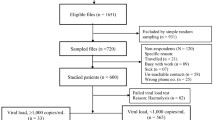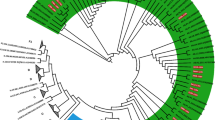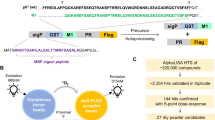Abstract
A major problem in the development of antiviral therapies for AIDS has been the emergence of drug resistance. We report an analysis of the structure of a Val 82 to Ala mutant of HIV-1 proteinase complexed to A-77003, a C2 symmetry-based inhibitor. Modelling studies predicted that the V82A mutation would result in decreased van der Waals' interactions with the phenyl rings of A-77003 in both S1 and S1′ subsites. Unexpected rearrangements of the protein backbone, however, resulted in favourable re-packing of inhibitor and enzyme atoms in the S1 but not the S1′ subsite. This analysis reveals the importance of enzyme flexibility in accommodating alternate packing arrangements, and can be applied to the re-design of inhibitors targeted to drug resistant variants which emerge in the clinic.
This is a preview of subscription content, access via your institution
Access options
Subscribe to this journal
Receive 12 print issues and online access
$259.00 per year
only $21.58 per issue
Buy this article
- Purchase on SpringerLink
- Instant access to full article PDF
Prices may be subject to local taxes which are calculated during checkout
Similar content being viewed by others
References
Debouck, C. The HIV-1 protease as a therapeutic target for AIDS. AIDS Res. hum. Retroviruses 8, 153–164 (1992).
Huff, J.R. HIV protease: a novel chemotherapeutic target for AIDS. J. med. Chem 34, 2305–2314 (1991).
Meek, T.D. Inhibitors of HIV-1 protease. J. enzym. Inhib. 6, 65–98 (1992).
Tomasselli, A.G., Howe, W.J., Sawyer, T.K., Wlodawer, A. & Heinrikson, R.L. The complexities of AIDS: an assessment of the HIV protease as a therapeutic target. Chimica Oggi 9, 6–27 (1991).
Erickson, J.W. Design and structure of symmetry-based inhibitors of HIV-1 protease. Perspect. Drug Discovery Design 1, 109–128 (1993).
Wlodawer, A. & Erickson, J.W. Structure-based inhibitors of HIV-1 protease. A. Rev. Biochem., 62, 543–585 (1993).
Appelt, K. Crystal structures of HIV-1 protease-inhibitor complexes. Perspect. Drug Discovery Design 1, 23–48 (1993).
Fitzgerald, P.M.D. & Springer, J.P Structure and function of retroviral proteases. A. Rev. Biophys. biophys. Chem. 20, 299–320 (1991).
Abdel-Meguid, S.S. Inhibitors of aspartyl proteinases. Med. Res. Rev. 13, 731–778 (1993).
Richman, D.D. HIV drug resistance. A. Rev. Pharmacol. Toxicol. 32, 149–164 (1993).
Otto, M.J. et al. In vitro isolation and identification of human immunodeficiency virus (HIV) variants with reduced sensitivity to C-2 symmetrical inhibitors of HIV type 1 protease. Proc. natn. Acad. Sci. U.S.A. 90, 7543–7547 (1993).
El-Farrash, M.A. et al. Generation and characterization of a human immunodeficiency virus type 1 (HIV-1) mutant resistant to an HIV-1 protease inhibitor. J. Virol. 68, 233–239 (1994).
Ho, D.D. et al. Characterization of human immunodeficiency virus type 1 variants with increased resistance to a C2-symmetric protease inhibitor. J. Virol. 68, 2016–2020 (1994).
Kaplan, A.H. et al. Selection of multiple human immunodeficiency virus type 1 variants that encode viral proteases with decreased sensitivity to an inhibitor of the viral protease. Proc. natn. Acad. Sci. U.S.A. 91, 5597–5601 (1994).
Kempf, D.J. et al. Antiviral and pharmacokinetic properties of C2 symmetric inhibitors of the human immunodeficiency virus type 1 protease. Antimicrob. Agents Chemother. 35, 2209–2214 (1991).
Hosur, M.V et al. Influence of stereochemistry on activity and binding modes for C2 symmetric-based diol inhibitors of HIV-1 protease. J. Am. chem. Soc. 116, 847–855 (1994).
Bhat, T.N., Sasisekharan, V. & Vijayan, M. An analysis of side-chain conformation in proteins. Int. J. pept. prot. Res. 13, 170–184 (1979).
Andrews, P.R., Craik, D.J. & Martin, J.L. Functional group contributions to drug-receptor interactions. J. med. Chem. 27, 1648–1657 (1984).
Baldwin, E.T., Hajiseyedjavadi, O., Baase, W.A. & Matthews, B.W. The role of backbone flexibility in the accommodation of variants that repack the core of T4 lysozyme. Science 262,, 1715–1721 (1993).
Markowitz, et al. Selection and analysis of human immunodeficiency virus type 1 variants with incresed resistance to ABT-538, a novel protease inhibitor. J. Virol. in the press.
Lui, B. Characterization of HIV-1 protease mutants from viral variants with reduced sensitivity to a protease inhibitor (Hood College; 1994).
Schechter, I. & Berger, A. Biochem. biophys. Res. Commun. 27, 157–162 (1967).
Author information
Authors and Affiliations
Rights and permissions
About this article
Cite this article
Baldwin, E., Bhat, T., Liu, B. et al. Structural basis of drug resistance for the V82A mutant of HIV-1 proteinase. Nat Struct Mol Biol 2, 244–249 (1995). https://doi.org/10.1038/nsb0395-244
Received:
Accepted:
Issue date:
DOI: https://doi.org/10.1038/nsb0395-244
This article is cited by
-
Computational analysis of amprenavir resistance triple mutant (V32I, I47V and V82I) in HIV-1 protease
Network Modeling Analysis in Health Informatics and Bioinformatics (2014)
-
Effects of the V82A and I54V mutations on the dynamics and ligand binding properties of HIV-1 protease
Journal of Molecular Modeling (2010)
-
The not-so-great escape
Nature Structural Biology (1995)



